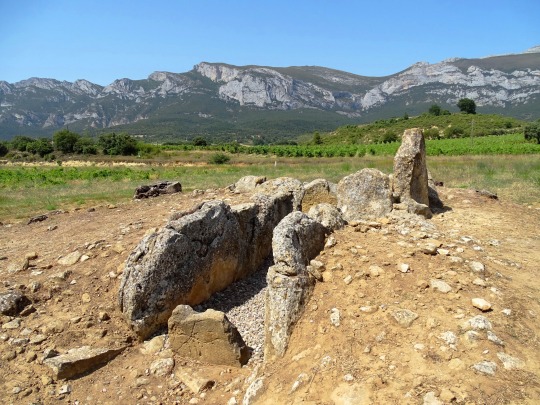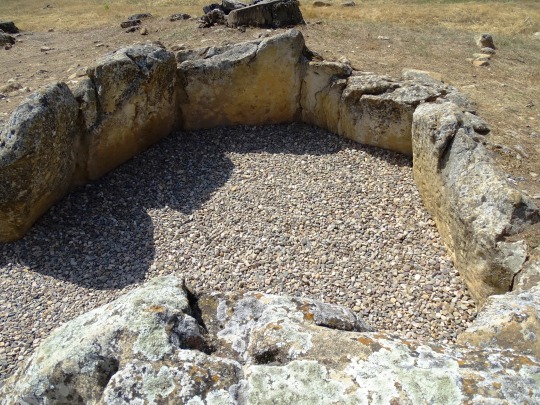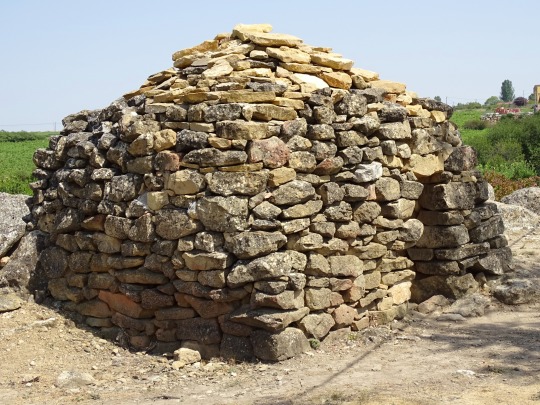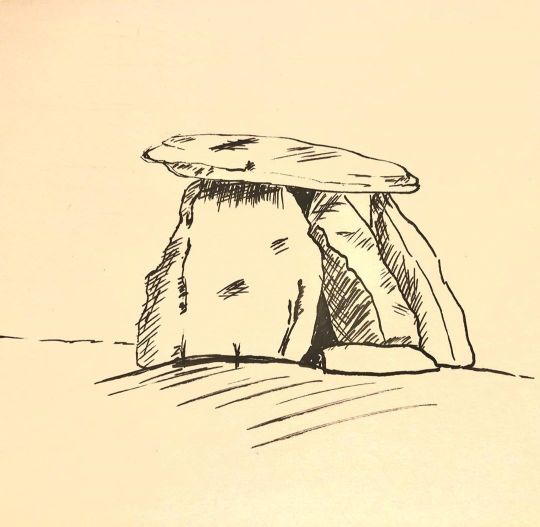#trikuharria
Text










El Sotillo Trikuharria Burial Chamber/Dolmen of San Martín, Spain
The dolmen of San Martín is a dolmen located next to the N-232a road, at kilometer point 63, which connects the town of Laguardia with Leza, in the Alava region of Rioja Alavesa in the Basque Country (Spain). It is considered one of the oldest constructions found in the world.
It is a corridor dolmen covered with flat slabs and burial chamber. All this surrounded by a circular tumulus of earth and stones that has been damaged by the farm. A special feature of this dolmen is the dual use that has occurred in two different eras. The monument was erected at the end of the Neolithic on a small hill that had a sacred character for the community. It suffered the fall of two of the slabs that made up the burial chamber at the end of the Neolithic early Chalcolithic and continued to be used until the end of the Chalcolithic or beginning of the Bronze Age. On the dolmen, leaning on the slabs of the dolmen chamber, a hut or guardaviñas has been built, which takes advantage of stones from the tumulus itself.
It was declared cultural assets in the category of monument and obtained the degree of protection of qualified by Decree 183/2011, of July 26, 2011 along with the other dolmens that make up the "Set of monuments" of the dolmens of the lowlands of the Historical Territory of Álava.
The burial chamber is polygonal formed by 10 large sandstone slabs. They have dimensions of 5.75 meters by 3.10 meters and a maximum height of 1.90 meters. The corridor has a length of almost 5 meters and a width of 1.20 meters with a height of 1.30 meters. It was covered with slabs and maintains one of them. In one of the five large slabs that form it there is a series of holes or bowls typical of megalithism art.1The tumulus, of stone and earth, has dimensions of 26 by 14 meters and a height of 2.15 meters, its northern part has disappeared having been damaged by the agricultural work of the field where it is located. It is estimated that the tumulus had a cover of white limestone from the nearby Sierra de Cantabria, the hypothesis is based on the fact that there are still stones of that type in the tumulus and in the salvaviñas hut that has been built on the dolmen supported on the orthostats of the northwest of the chamber.
Source: Wikipedia
#El Sotillo Trikuharria Burial Chamber#Dolmen of San Martín#Laguardia#Rioja Alavesa#Basque Country#Neolithic#archaeology#ruins#free admission#travel#original photography#vacation#tourist attraction#landmark#architecture#landscape#Northern Spain#Southern Europe#España#summer 2021#nature#flora#Spanish history
11 notes
·
View notes
Photo

Inktober day 23 ANCIENT #inktober #inktober2019 #ancient #illustration #dolmen #trikuharria #ilustracion #antiguo https://www.instagram.com/p/B39AyBansW2/?igshid=h9qsbj29h9f3
1 note
·
View note
Photo

Photo:Sagastietako trikuharria by sorginmendi http://flic.kr/p/Qd48Wd
0 notes
Text










El Sotillo Trikuharria Burial Chamber, Spain (No. 1)
El Sotillo is a rock in Leza, in Rioja Alavesa, on the border with the municipality of Laguardia. Like other tricularis around it, it was built at the end of the Neolithic or at the beginning of the Chalcolithic. It is part of the megalithic station of Alabar Rioja. The bodies found there have offered various results, in the field of ancient genetics.
It is a corridor-type megalithic tomb. The tomb is an oval chamber (3.30 m x 2.90 m), and has nine slabs, one of which is 2.29 meters high. The corridor (0.60 m wide, 1.30 m high) is limited by five slabs. Around the monument is a mound made of earth and small stones, with a diameter of about 18 meters. The track to get there cuts a part of the mound itself.
, on the border with the municipality of Guardia . Like other tricularis around it, it was built at the end of the Neolithic or at the beginning of the Chalcolithic. It is part of the megalithic station of Alabar Rioja. The bodies found there have offered various results, in the field of ancient genetics.
It is a corridor-type megalithic tomb. The tomb is an oval chamber (3.30 m x 2.90 m), and has nine slabs, one of which is 2.29 meters high. The corridor (0.60 m wide, 1.30 m high) is limited by five slabs. Around the monument is a mound made of earth and small stones, with a diameter of about 18 meters. The track to get there cuts a part of the mound itself.
Source: Wikipedia
#El Sotillo#El Sotillo Trikuharria Burial Chamber#Álava#megalithic corridor grave#Basque Country#Rioja Alavesa#Laguardia#Neolithic#archaeology#ruins#travel#original photography#vacation#tourist attraction#landmark#landscape#countryside#Spanish history#Northern Spain#Southern Europe#Spain#España#summer 2021#free admission
0 notes